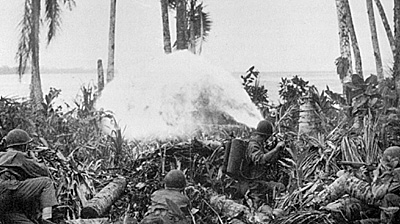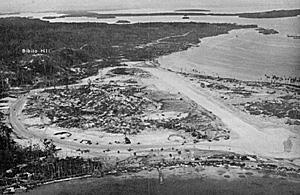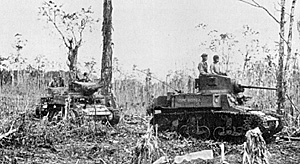The Americans did not yet know it, but the worst was over. All regiments began making steady progress each day against light, though determined and skillful, opposition. (Unless otherwise indicated all lessons-learned data are from CG XIV Corps, Informal Report on Combat Operations in the New Georgia Campaign. This document is not a narrative report. It contains data on tactics, weapons, logistics, and special jungle problems as compiled by the corps, division, and special headquarters participating in the operation.)
By now all regiments, though depleted by battle casualties and disease, had become veterans. Pockets that once would have halted an entire battalion or even a regiment were now usually reduced with speed and skill. The flame thrower, receiving its most extensive use in the Pacific up to this time, was coming into its own as an offensive weapon. All regiments employed it against enemy positions, both in assault and in mopping up. The flame thrower did have several important disadvantages. The equipment was large and heavy, and required the operator to get very close to enemy positions, then expose his head and body in order to use his weapon. He needed to be protected by several riflemen. But even with its disadvantages, it was useful in destroying enemy positions.
Tanks, too, were of great value. General Griswold felt that, despite the difficulties inherent in operations over hilly jungle, the actions of the Tank Platoons of the 9th and 10th Marine Defense Battalions had been successful. On 29 July, looking forward to fighting over easier terrain around Munda airfield, he asked General Harmon for more tanks. Corps headquarters, he also announced, was preparing to mount flame throwers on tanks (Rad, Griswold to Harmon, 29 Jul 43, in XIV Corps G-3 jnl, 30 Jul 43. Part of the 754th Army Tank Battalion was alerted at Noumea for transfer to Guadalcanal to be equipped with flame throwers for employment in New Georgia but Munda airfield had fallen before it was moved. The Tank Platoon of the 11th Marine Defense Battalion arrived in early August.)
The operation ended before flame throwing tanks could be used, but the idea was successfully carried out in later campaigns.
The technique of reducing a pillbox, whether isolated or part of a defensive system, was now mastered. The official records unfortunately do not give much exact information on the reduction of specific pillboxes, but after the battle the 37th Division gave a valuable general description of the methods employed.
The first essential was a complete reconnaissance to develop the position, intention, and strength of the enemy. This was quite difficult in the jungle. "To one unskilled in jungle fighting, it is inconceivable that well trained reconnaissance patrols in sufficient numbers cannot develop the situation in front of the advancing forces." (37th Div Rpt, G-3 Narrative, jungle Tactics and Opns, P. 3.)
Because they could not see far enough, because they could not always get close enough, and because Japanese fire discipline was sometimes so good that a given position would not fire until actually attacked, reconnaissance patrols could not always develop positions. The next step was a reconnaissance in force by a reinforced platoon. This often uncovered a portion of the enemy position but not all of it. Usually the complete extent of a center of resistance was determined only by the attack.
Three-Part Attack
The attack itself consisted of three parts: artillery preparation, 81-mm. mortar fire, and assault.
The artillery preparation had a threefold effect. It improved visibility by clearing away brush and foliage. It destroyed or damaged enemy positions. And it killed, wounded, and demoralized enemy soldiers.
The 81-mm. mortars, using heavy shell that had a delay fuze, fired on observed positions and usually covered the area between the American infantry and the artillery's targets. They frequently drove the Japanese soldiers out of their pillboxes into the open where they became targets for rifle and machine gun fire. The 60-mm. mortars, though more mobile than the 81-mm.'s, threw too light a shell to be very effective in these attacks. Their shells usually burst in the trees, but the 81-mm. heavy shells penetrated the treetops and often the tops of the pillboxes themselves before exploding.
The assault consisted of a holding attack by a company or platoon delivering assault fire to cover a close-in single or double envelopment. BAR's, M1's, and grenades were used extensively, and flame throwers were employed whenever possible. Units of the 25th Division, which later drove northward from Munda to Zieta, encountered pillbox positions that were too shallow, and in country too dense, for artillery and mortars to be used without endangering the attacking infantry. Men of this division therefore advocated flame throwers, infantry cannon, and tanks for pillbox reduction.
 REDUCING AN ENEMY PILLBOX WITH A FLAME THROWER. Pillbox is along the
beach near Munda Airfield.
REDUCING AN ENEMY PILLBOX WITH A FLAME THROWER. Pillbox is along the
beach near Munda Airfield.
These techniques, which simply represented the application of established tactical principles, were being applied well in early August, but several problems remained. Because the infantry units did not advance at the same rate, the front line became irregular and the supporting artillery was thus unable to capitalize on the advantages of firing at right angles to the axis of advance. All unit commanders were eager to employ artillery and mortar support to the utmost, but they frequently complained that neighboring units' supporting artillery and mortar fires were falling in their areas and endangering their troops. They had a tendency to forget that the enemy also used artillery and mortars and, when receiving American artillery fire, frequently lobbed 90-mm. mortar shells into the American front lines to convince the American infantrymen that they were being fired on by their own artillery. In most cases the complaints were probably caused by Japanese rather than American fire.
Because maps were inaccurate and reconnaissance was inhibited by poor visibility, it was extremely difficult to determine the exact location of friendly units. In the 37th Division's zone several artillery preparations were called off because of uncertainty about the position of the 148th Infantry. Flares and smoke pots, and sometimes flame throwers, were used to mark flanks, but usually could not be seen by anyone not in the immediate vicinity. Griswold had ordered the front line battalions to mark their flanks daily with white panels twenty-five feet long by six feet wide. These were to be photographed from the air. Reconnaissance planes made daily photographic flights, but there were no clearings in the New Georgia jungle large enough to permit the panels to be spread out, and this effort failed.
By plotting close-in defensive artillery fires, forward observers were able to provide some reliable information on the location of front lines. When the 37th Division rolled forward after 1 August, it estimated positions and distances on the basis of speedometer readings from locations that had been plotted by air photography and interpolated on maps.
The difficulties of scouting and patrolling naturally affected nearly every aspect of the operation. Because enemy positions could not be fixed in advance, the troops often attacked terrain rather than the enemy. This procedure resulted in slow advances and in a high expenditure of mortar ammunition on areas actually free of the enemy. And mortar ammunition supply was laborious; shells had to be hand-carried from trail-end to the mortar positions. Poor scouting caused battalions to advance on narrow fronts and thus be halted by small enemy positions. One regimental operations officer asserted that inadequate reconnaissance was due in part to the fact that "higher commanders" did not issue orders until the late afternoon preceding an attack. Thus battalions did not have time for full reconnaissance:
"Many times, units were committed in an area which had not been reconnoitered. This fact resulted in commanders having to make decisions concerning a zone of advance in which he knew little or nothing about the enemy positions. Enemy strong points encountered in this fashion often times resulted in hasty withdrawals which were costly both in men and weapons." ( Rpt, Maj Carl H. Coleman, S-3 145th Inf, to 37th Div, 1 Sep 43, sub: Informal Rpt on New Georgia Campaign.)
 "Munda is yours"
"Munda is yours"
The XIV Corps maintained the momentum of its advance against the enemy delaying forces.
MUNDA AIRFIELD
On 2, 3, 4, and 5 August the advance continued all across the corps' front. The 103d and 169th Infantry Regiments, which had gained the outer taxiways of the airfield on 1 August, kept going. The 3d Battalion, 172d, was committed on the 169th's right on 4 August. In the more open terrain around the airstrip the troops were able to use 60-mm. mortars effectively, and their advance was consequently speeded. Kokengolo Hill, the rise in the center of the airfield where a Methodist mission had once stood held up the advance temporarily. Bibilo Hill, whose fortifications included six 75- mm. antiaircraft guns that the Japanese had been using as dual-purpose weapons, was reduced in three days of action by elements of the 169th, 172d, 145th, and 161st Regiments, supported by Marine tanks. The 148th Infantry, on the north flank, established blocks and ambushes on a north-south track that was presumed to be the Munda-Bairoko trail.
 LIGHT TANKS M3 OF THE 9TH MARINE DEFENSE BATTALION supporting
infantry action near the base of Bibilo Hill.
LIGHT TANKS M3 OF THE 9TH MARINE DEFENSE BATTALION supporting
infantry action near the base of Bibilo Hill.
On 5 August, with Bibilo Hill cleared, the units of the 37th Division crossed the narrow strip of land between the hill and the water. This tactical success had one effect of great personal importance to the soldiers: many had their first bath in weeks.
In the 43d Division's zone on 5 August, the infantry, with tank and mortar support, killed or drove the last Japanese from the tunnels, bunkers, and pillboxes of Kokengolo Hill. Here were found caves stocked with rice, bales of clothing and blankets, and occupation currency. Crossing the western part of the runway, with its craters, grass, and wrecked Japanese planes, the infantrymen secured it in early afternoon. General Wing telephoned General Hodge from Bibilo Hill: "Munda is yours at 1410 today.." (43d Div G-3 Jul, 5 Aug 43.)
Griswold radioed the good news to Admiral Halsey: ". . . Our ground forces today wrested Munda from the Japs and present it to you . . . as the sole owner. . . ." Halsey responded with "a custody receipt for Munda .... Keep 'em dying. " (Rad, CG NGOF to COMSOPAC, 5 Aug 43, in XIV Corps G-3 Jul, 5 Aug 43; Rad, COMSOPAC to CG NGOF, 6 Aug 43, in XIV Corps G-3 Jul, 7 Aug 43.)
The major objective was in Allied hands. The hardest part of the long New Georgia battle was over.
More XIV Corps Offensive
- Plans
Ilangana and Shimizu Hill
Attack Against the Ridges
Advance and Withdrawal
Jungle Techniques and Problems
Back to Table of Contents -- Operation Cartwheel
Back to World War Two: US Army List of Issues
Back to MagWeb Magazine List
© Copyright 2002 by Coalition Web, Inc.
This article appears in MagWeb (Magazine Web) on the Internet World Wide Web.
Other military history articles and gaming articles are available at http://www.magweb.com